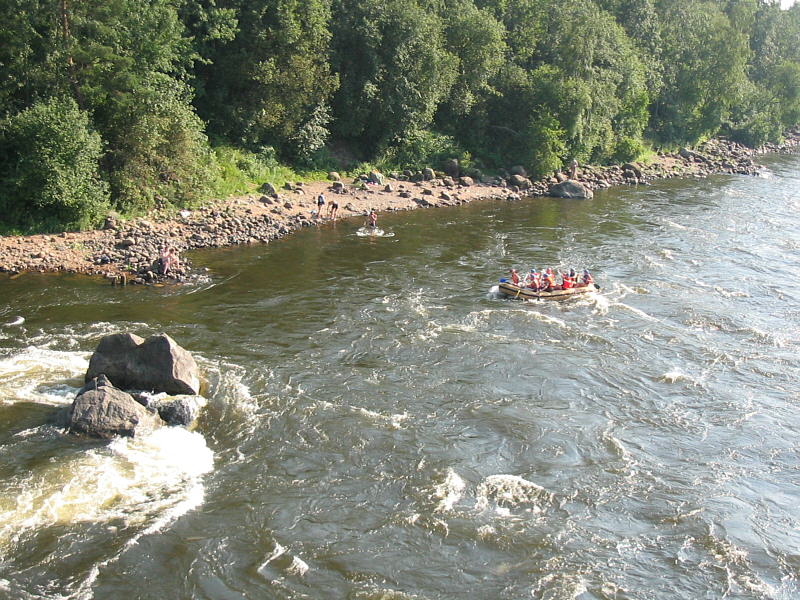- Vuoksi River
Infobox River | river_name = River Vuoksi (Vuoksa)

caption =
origin =Lake Saimaa
mouth =Lake Ladoga
basin_countries =Finland ,Russia
length = 162 km (101 mi)
elevation = 74 m (243 ft)
discharge = 540 m³/s (19,073 ft³/s)
watershed = Greater than 52,400 km² (20,232 mi²)The Vuoksi River ( _ru. Вуокса; _fi. Vuoksi; _sv. Vuoksen) runs in the northernmost part of theKarelian Isthmus fromLake Saimaa in southeasternFinland toLake Ladoga in northwesternRussia . The river enters Lake Ladoga in three branches, an older main northern branch atPriozersk (Käkisalmi), a smaller branch few km. to the north of it and since 1857 a new southern branch entering fifty kilometers further southeast asBurnaya River (Finnish: Taipaleen joki), which has become the main stream in terms of water discharge. It should be noted that the old northern distributaries drain only the lower reaches of the Vuoksi basin after 1857 and are not fed by waters of the Lake Saimaa. Northern and southern branches actually belong to two separate river systems, which at times get isolated from each other in dry seasons.The descent between Lake Saimaa and Lake Ladoga is 69 meters. The entire run of the river is 162 kilometers via the Priozersk branch or 150 kilometers via the Taipale branch. For most of its length, the river broadens out to a series of lakes bound together by shorter riverlike connections. One of these lakes, "Suurselkä" close to Priozersk, is by the Russians renamed to "Ozero Vuoksa" ("Lake Vuoksa").
.
During both the Winter and
Continuation War s the river Vuoksi was a major Finnish defensive line against the Soviet advance. TheMannerheim Line andVKT-line were situated along the northern shore of its southern armlet.At the
Industrial Revolution , power generated from Vuoksi's rapids made the Vuoksi region Finland's industrial center in the late 19th century. Since the Winter War (1940), the Karelian Isthmus belongs to Russia and only 13 kilometers of the river's length remains in Finland.The major power stations at Tainionkoski and Imatra are on the Finnish side in the center of the city of
Imatra .The river's surroundings, including the
Korela Fortress (formerly: "Käkisalmi"), is a popular resort forSaint Petersburg 's residents.The river is famous for the great
rapid s, for instance atImatra and the village of Losevo. The rapid junction of the Vuoksi and Suvanto/Lake Sukhodolskoye at Losevo is a popular place ofkayak ,canoe andcatamaran competitions.A project is currently being discussed in Russia to destroy the rapids at Losevo and turn the River Burnaya, Lake Sukhodolskoye and lower portions of Vuoksi into a navigable canal, which would connect
Lake Ladoga to theGulf of Finland and allowoil tankers to bypassRiver Neva and the city ofSaint Petersburg . [http://www.ecominfo.spb.ru/news/index.php?id=1019]Geological history
" 322.1-3, 205-215.] [Saarnisto, Matti (1970). The Late Weichselian and Flandrian history of the Saimaa Lake complex. "Societas Scientiarium Fennicae. Commentationes Physico-Mathematicae" 37.]
In 1818 a canal, which was dug to drain spring flood waters from
Lake Suvanto (now Lake Sukhodolskoye, a 40-km long narrow lake in the eastern part of theKarelian Isthmus ) intoLake Ladoga , unexpectedly eroded and turned intoTaipaleenjoki (now Burnaya River). Taipaleenjoki started draining Suvanto and decreased its level by 7 m. Originally waters of Lake Suvanto flowed into Vuoksi River through a waterway atKiviniemi (now Losevo), but as a result of the change, the waterway dried out. In 1857 the channel was dug there, but the stream reversed direction, revealedrapids and rendered navigation at Kiviniemi impossible. Since 1857 Suvanto and Taipaleenjoki have constituted the southern armlet of Vuoksi River, which has decreased the level of the original northern armlet emptying into Ladoga nearKexholm (now Priozersk) by 4 m and become the main stream.References
External links
* [http://www.ekarjala.fi/vivatvuoksia/kuvat.html Aerial photos from the River Vuoksi in Russia]
* [http://www.loiro.ru/setevoe/priozersky/vuoksa.htm History of Vuoksi] (in Russian)
Wikimedia Foundation. 2010.
